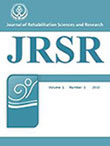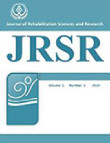فهرست مطالب

Journal of Rehabilitation Sciences and Research
Volume:5 Issue: 2, Jun 2018
- تاریخ انتشار: 1397/03/18
- تعداد عناوین: 5
-
-
Pages 31-35BackgroundThe shoulder complex is known as one of the most mobile joints of body whose frequently use for overhead movements causes changes in the shoulder joint range of motion. Sub-acromial impingement syndrome (SIS) is one of the most common causes of shoulder pain affecting shoulder joint range of motion. The purpose of this study was to compare shoulder joint functional range of motion in overhead athletes with and without Shoulder impingement syndrome.MethodsThe current research is a cross-sectional study, in which 63 male overhead athletes (30 subjects without impingement syndrome (age: 28.12±6.13 y/o) and 33 subjects with impingement syndrome (age: 26.83±4.81 y/o)) threw a handball ball three times, while seating on a chair. A 6-camera Vicon Motion Capture system recorded the markers placed on the upper limb and trunk during each of the throwing conditions. To evaluate the range of motion, a whole-body kinematic model was used in OpenSim software, with inverse kinematics used to obtain adequate joint angles (shoulder joint abduction as well as internal and external rotation).ResultsThe results indicated that the external rotation and abduction range of motion were greater in the athletes with shoulder impingement syndrome in comparison to those without impingement syndrome (P <0/001 and p= 0.04, respectively), while their internal rotation range of motion were more limited than that of athletes without impingement syndrome (p<0/001).ConclusionOverhead athletes with impingement syndrome have greater glenohumeral external rotation and abduction and less internal rotation in the throwing shoulder in comparison to athletes without impingement syndrome. These findings can be used to screen and identify high-risk athletes and help the therapists to make more appropriate therapeutic plans in order to assist the injured athlete to return to sports as soon as possible.Keywords: Shoulder joint, Functional Range of Motion, Overhead Athlete, impingement syndrome
-
Pages 36-40BackgroundThe aim of this paper was to prepare the Persian version of the unique International Edition of the self-report Hearing Aids questionnaire and to assess its validity and reliability. This questionnaire was chosen because of its simplicity, comprehensiveness for users, and usefulness, in comparison with other evaluations of outcomes hearing aids.MethodsPermission to translate International Outcome Inventory for Hearing Aids was obtained from its developer. The questionnaire was translated back into Persian, and then the translated version was retranslated to English by qualified individuals to assess its correspondence with the original version. After this stage, the content validity of the questionnaire was checked by nine audiology experts, with the results analyzed by Lawshe statistical method. In order to examine the structural reliability, the questionnaire was completed by 15 hearing impaired people and the necessary corrections were made according to the results. Finally, the final form was answered by 90 hearing-aid users, with the Cronbach’s alpha statistical method utilized to analyze the results. In order to assess the test-retest reliability, the questionnaire was recompleted again by 30 subjects 1-2 weeks later, with the paired t-test correlation employed to evaluate the results.ResultsThe mean total score was 26.41 (SD=4.86). The test-retest results revealed no significant difference between the two groups. The internal consistency was 0.845 based on Cronbach’s alpha, indicating acceptable test reliability.ConclusionThe present study demonstrated that the Persian version of the International Outcome Inventory for Hearing Aids possesses a good validity and reliability.Keywords: Self- report Questionnaire, Hearing aid
-
Pages 41-45BackgroundBalance is an indispensable part of daily activities and is considered important in examining the performance of athletes especially in basketball. Despite the advantages of neck proprioceptive neuromuscular facilitation (PNF) training on neck proprioception, it has remained understudied. Neck proprioception is very important for performance in exercise. Therefore, the aim of this study was to evaluate the effect of neck PNF training on neck proprioception on postural stability and limit of stability in elite female basketball players.MethodsIn this study, 30 female basketball players with at least three years of basketball activity were randomly assigned into two groups: experimental group (neck PNF training) and control group. The experimental group participated in 4-week neck PNF training sessions (12 sessions per week). On the other hand, the control group performed only daily routine exercises. Limit of stability and postural stability index of the participants were determined by the Biodex balance test before and after the exercise program. Independent t-test (between the two groups) and paired t-test (in each group) were applied using the SPSS-18 software to analyze the obtained data, with a significance level of p<0.05 adopted.ResultsThe results indicated that after 4 weeks of neck PNF training, the means of overall stability index in the exercise group decreased from 1.47±0.27 to 0.92±0.07 (P<0.001). Also, for mediolateral index, it declined from 1.17±0.37 to 0.85±0.35 (P=0.04), and for the anteroposterior index it fell from 1.14±0.13 to 0.92±0.08 (P<0.001). However, there were no significant differences between prepost training in the control group.ConclusionThese results provide evidence that neck PNF training can be used to enhance the postural stability and limit of stability indices of basketball players. The neck proprioception may be improved with training programs, and neck PNF training improved postural stability index can reduce sports injuries and enhance athletic performance.Keywords: proprioception, Biodex, basketball, neck
-
Pages 46-52BackgroundLifestyle change through diet and exercise is first line therapy for non-alcoholic fatty liver disease (NAFLD), which is associated with increase in risk of cardiovascular disease. Therefore the aim of this study was to investigate the effect of endurance training and low calorie diet on levels of homocysteine and plasma lipid profiles in men with NAFLD.Methods70 patients with NAFLD [weight 89.6±5.8 , age 39.2±0.5 years, body mass index (BMI) 29.4±1.9 kg/m2] were randomly assigned into four groups(training, diet, combined of training & diet, and control). The endurance training program included moderate intensity training with 55-75% of maximal heart rate for 45 min/session, 3 times/week for 8 weeks. Low calorie diet with an energy deficit of 500 calories of daily energy intake was calculated from 3-day food records of the patients. Blood samples were measured before and after intervention. Homocysteine levels and lipid profiles were measured before and after intervention.ResultsFifty out of the 70 of the participants completed the trial. There were no serious adverse effects. Result exhibited that interaction of endurance training and low calorie diet decrese blood LDL-C (P=0.001), TG (P=0.006), TC (P=0.011) and homocysteine (P=0.001), whereas increased HDL-C (P=0.001) levels significantly.ConclusionThis study demonstrated that endurance training and low calorie diet interventions are effectiveness in reducing lipid profile and homocysteine levels among patients with NAFLD. However, combined interventions specifically improves NAFLD and has a better effect.Keywords: Non-alcoholic Fatty Liver disease, Exercise, Caloric Restriction, Homocysteine
-
Pages 53-62BackgroundThe present study aimed at studying the morningness-eveningness chronotype (MEC) of daily and weekly biorhythm fluctuations in the aggression of preschool children.MethodsThis was a causal-comparative study. The statistical population was preschool children in Tehran. One hundred children were selected through purposive sampling. They were examined at different times of day (08:00, 10:00, 13:00 and 15:00) and different days of the week (Saturday, Sunday, Monday, Tuesday and Wednesday). The data collection tool used was the MEC questionnaire for children, a behavioral questionnaire for preschool children and a self-report questionnaire about aggression. The data was analyzed using mixed ANOVA.ResultsThe results showed that the aggressive behavior of pre-school children in the educational environment varies throughout the day and week. Also, the aggressive performance of preschool children in the morning differed from that of mid-session children or evening-type children in the educational environment during the week (P<0.01).ConclusionThe results of the behavioral questionnaire showed that the effect of the group on the level of aggression was not significant, but the effect of the day of the week and time of day was significant.Keywords: Time merphology, Fluctuation, Preschool, Agression


